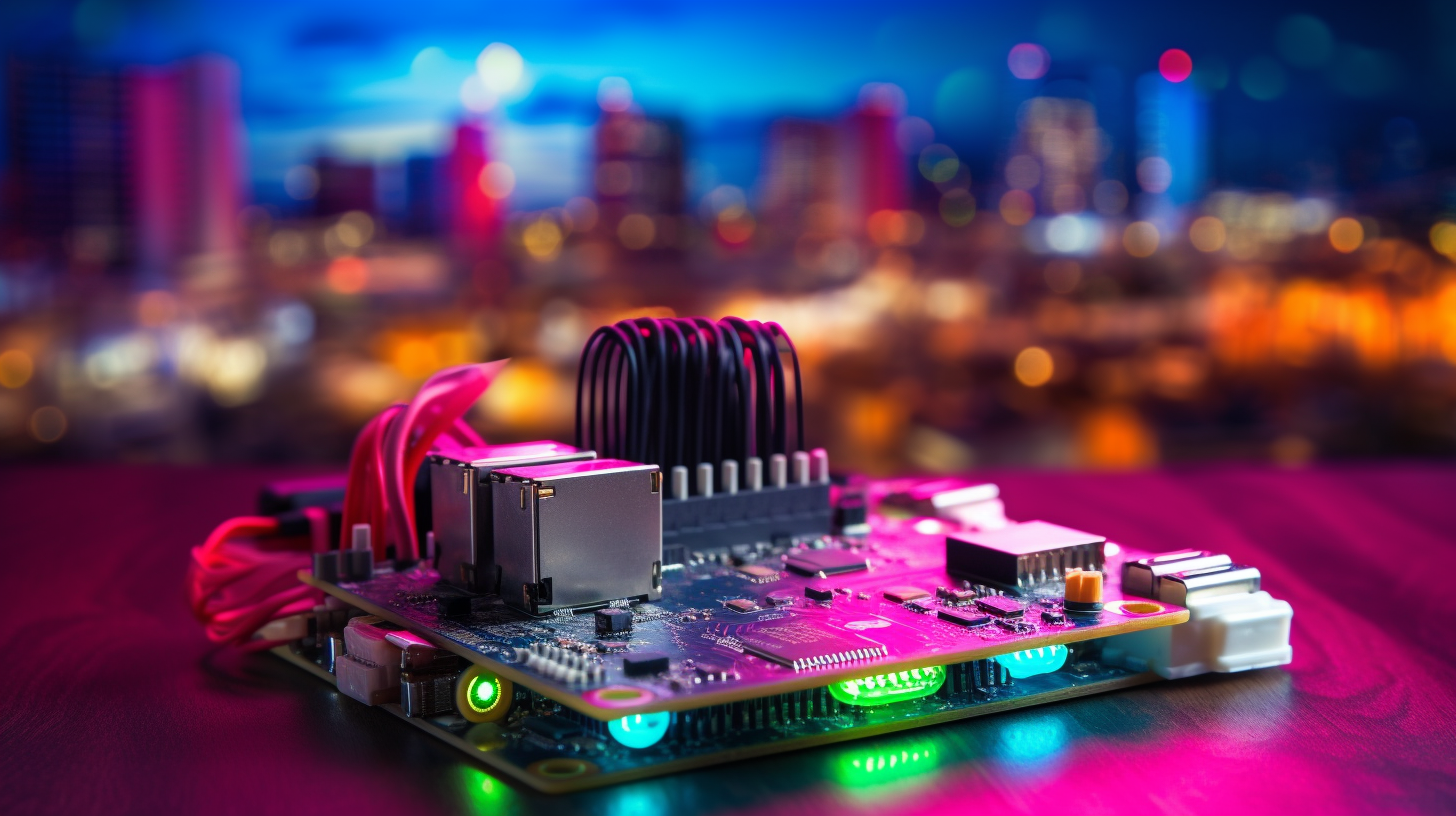Last Updated on September 28, 2023 by tech pappy
What can revolutionize the world of computing and fit in the palm of your hand?
Presenting the latest offering from the Raspberry Pi Foundation: the Raspberry Pi 5. With a powerful processor and upgraded features, this credit-card-sized computing platform promises to be reliable, affordable, and feature-rich.
Equipped with dual 4K displays and USB-C power delivery, the Raspberry Pi 5 is ready to take computing to new heights.
Discover the possibilities of this tiny package and prepare to be amazed.
Overview of Raspberry Pi 5
The Raspberry Pi 5 is a credit-card-sized computer that boasts impressive features and specifications. With prices starting at $60 for a 4GB version and $80 for an 8GB version, it offers over 2.5 times the speed of the Pi 4.
The device includes two USB 3 controllers, gigabit Ethernet, and control over all the GPIO pins. It also features dual-purpose camera and display ports, a Micro SD card slot, a PCIe connector, and a power management chip.
The BCM 2712 SOC, equipped with a quad-core ARM A76 CPU and video-core 7 GPU, delivers high-end performance. The Pi 5 can handle up to 25 watts of power, which is an increase from previous models.
It has eliminated through-hole components in favor of surface-mount components, making it an ideal choice for users seeking freedom and flexibility.
Connectivity and Expansion Options
The connectivity and expansion options of the Pi 5 provide users with increased freedom and flexibility. It offers two USB 3 controllers for full five gigabit bandwidth, two USB 2 controllers, and a gigabit Ethernet connection.
Additionally, the board includes a microSD card slot that’s twice as fast as the one on the Pi 4. It also features a PCI Express (PCIe) connector, dual-purpose camera and display ports, and a UART header for serial console access. These options ensure users have ample connection possibilities for various peripherals, allowing them to customize their experience.
Moreover, the Pi 5 comes with a power management chip that has a built-in real-time clock and USB-C power delivery. The memory resistor indicates the RAM capacity, while a power button, dual-purpose status LED, and battery connector for the clock provide extended control.
All these features combine to give users the freedom to create and explore without any limitations.
Power Management and Additional Features
Power management and additional features of the Pi 5 provide users with increased control and flexibility. The Pi 5 boasts a power management chip with a built-in real-time clock and USB-C power delivery for easy power consumption measurement. The board also includes a separate UART header for serial console access and a memory resistor indicating the RAM capacity.
Moreover, the Pi 5 offers a power button, a dual-purpose status LED, and a battery connector for the clock. With its increased power requirements, capable of handling up to 25 watts, the Pi 5 is the perfect solution for those seeking more powerful options. These features open up a plethora of possibilities for users to explore with the Pi 5.
It is important to highlight that the Pi 5’s power management capabilities and additional features enhance the user experience. The inclusion of a power button and a dual-purpose status LED allows for convenient control and monitoring.
The separate UART header provides easy access to the serial console, enabling seamless communication and troubleshooting. The memory resistor indicating the RAM capacity aids in system configuration and optimization.

Furthermore, the Pi 5’s battery connector for the clock ensures uninterrupted timekeeping even during power outages. This feature adds an extra layer of reliability to the device. Additionally, the USB-C power delivery allows for easy and accurate measurement of power consumption, enabling users to efficiently manage their energy usage.
With these enhanced power management features and additional functionalities, users can now enjoy a wide range of possibilities and elevated control over their Pi 5 experience. The Pi 5 empowers users to embrace the freedom of customization and exploration, making it an essential tool for both professionals and enthusiasts alike.
Design Changes and Component Placement
The Pi 5 boasts enhanced power management features and additional functionalities, as well as design changes and component placement.
The board has transitioned to an entirely surface mount, eliminating through-hole components. The PoE (Power over Ethernet) header has been relocated, and the USB and Ethernet ports are now arranged in the same order as the Pi 3. Furthermore, the AV Jack has been replaced with a header for analog video out.
The board also features a narrow FPC connector for the camera and display connectors, allowing for easier component placement, reduced space requirements, improved power management, and faster connection and expansion options.
These design changes and component placement on the Pi 5 result in a more efficient use of space, improved power management, and faster connection and expansion options. As a result, the Pi 5 is a powerful and versatile option for individuals seeking a reliable and affordable Raspberry Pi board.
Performance and Power Requirements
Driving its impressive performance, the Raspberry Pi 5 is equipped with a powerful BCM 2712 SOC and a quad-core ARM A76 CPU running at 2.4 GHz.
The video core 7 GPU has the ability to decode H.265 up to 4K and 60fps, and the Pi 5 can drive two 4K displays at 60Hz.
It’s able to handle up to 25 watts of power, and the power requirements have increased compared to the Pi 4.
The memory resistor indicates the RAM capacity, which can be 1GB, 2GB, 4GB, or 8GB.
The Pi 5 also features a power management chip with a built-in real-time clock and USB-C power delivery.
This allows for power consumption measurement and provides flexibility.
Comparison to the Raspberry Pi 4
Comparing the Raspberry Pi 5 to its predecessor, the Raspberry Pi 4, it’s evident that the former is more powerful and capable. It boasts significantly higher processing power, dual-purpose camera and display ports, a PCI Express connector for high-speed expansion, and a memory resistor indicating the RAM capacity.
The Pi 5 also features a power management chip with a real-time clock, USB-C power delivery, and a power button. With its ability to drive two 4K displays at 60 Hz, the Pi 5 is an impressive upgrade from the Pi 4.
Furthermore, its power requirements have increased, and it can handle up to 25 watts. Overall, the Raspberry Pi 5 is a powerful, capable, and cost-effective upgrade from its predecessor.
Available Accessories and Peripherals
What accessories and peripherals are available for the Raspberry Pi 5?
The Raspberry Pi 5 offers a range of accessories and peripherals that are designed to enhance its connectivity and features.
- The RP1 chip provides two USB 3 controllers and two USB 2 controllers, allowing for improved connectivity.
- Additionally, the board supports gigabit Ethernet, full control over all GPIO pins, and the ability to drive two 4K displays at 60 Hz.
- The microSD card slot on the Raspberry Pi 5 is also twice as fast as the one on the Pi 4.
- Furthermore, the power management chip includes a real-time clock and supports USB-C power delivery.
With these features, the Raspberry Pi 5 can be used for a variety of projects and applications.
Benefits of the Raspberry Pi 5
The Raspberry Pi 5 offers a range of advantages, including improved performance, expanded connectivity, and enhanced power management. This powerful minicomputer is an excellent option for those seeking an affordable and energy-efficient solution for various projects.
Here are four benefits of the Raspberry Pi 5:
- With a quad-core ARM A76 CPU running at 2.4GHz, the Raspberry Pi 5 is over 2.5 times faster than the Pi 4.
- It features dual-purpose camera and display ports, gigabit Ethernet, and USB 3 controllers, enabling a full five gigabit bandwidth.
- A power management chip with a built-in real-time clock and USB-C power delivery makes advanced power management possible.
- The Raspberry Pi 5 also includes a memory resistor that indicates the RAM capacity, ranging from 1GB to 8GB.
The Raspberry Pi 5 is an excellent choice for makers, students, and educators, providing a versatile and affordable platform for various projects. Its strength and flexibility make it the next generation of minicomputers.
Potential Drawbacks of the Raspberry Pi 5
Considering its advantages, the Raspberry Pi 5 still has some potential drawbacks. The increased power requirements of the Pi 5 restrict its handling capacity to 25 watts, making it unsuitable for certain applications.
Additionally, the board does not have a traditional AV Jack, but instead, it has a header for analog video out. Some users may also have concerns about the inclusion of a power management chip.
Furthermore, due to the fact that the board is entirely surface-mount, customization of the hardware may prove challenging for users.
| Pros | Cons |
|---|---|
| Over 2.5x faster than Pi 4 | Increased power requirements |
| Dual-purpose camera and display ports | AV Jack replaced with header |
| Power management chip | Entirely surface mount |
| A memory resistor indicates RAM capacity | Limited to 25 watts |
Tips and Tricks for Getting Started
Getting started with the Raspberry Pi 5 can be intimidating, but with some helpful guidelines, it’s easy to get up and running. Here are some tips to get you started:
- Review the specifications: Familiarize yourself with the specifications of the Raspberry Pi 5 to understand its capabilities and usage.
- Check the power requirements: Ensure that your power source can provide the necessary 25 watts to the Pi 5.
- Set up the hardware: Assemble the Raspberry Pi 5 and any expansion cards carefully.
- Connect to the Internet: Reliable network connectivity is important to access the operating system required for the Pi 5.
Frequently Asked Questions
What Is the Cost of the Raspberry Pi 5?
The Raspberry Pi 5 is available for purchase at a starting price of $60 for the 4GB version and $80 for the 8GB version. This latest model offers various connectivity and expansion options, such as USB 3 controllers, gigabit Ethernet, and a PCI Express connector. It is worth noting that the Raspberry Pi 5 has higher power requirements, supporting up to 25 watts.
Does the Raspberry Pi 5 Support Wireless Connectivity?
Yes, the Raspberry Pi 5 offers wireless connectivity through its two USB 3 controllers, gigabit Ethernet, and control over all GPIO pins. It provides users with convenient and data-driven connectivity, along with power management features and a dual-purpose status LED.
Is the Raspberry Pi 5 Faster Than the Raspberry Pi 4?
Yes, the Raspberry Pi 5 is more than 2.5 times faster than the Pi 4. It features a new RP1 chip with a quad-core ARM A76 CPU running at 2.4GHz, allowing it to decode h.265 up to 4K and 60fps. It can drive two 4K displays at 60Hz.
Does the Raspberry Pi 5 come with any accessories?
The Raspberry Pi 5 does not come with any accessories. It is solely the board itself and requires the user to purchase all the necessary components separately.
Can the Raspberry Pi 5 be used for gaming?
Yes, the Raspberry Pi 5 can be used for gaming. Its quad-core ARM A76 CPU runs at 2.4GHz, providing powerful performance.
The video core 7 GPU is also impressive, capable of decoding H.265 up to 4K and 60fps, as well as driving two 4K displays at 60Hz. This makes it an ideal choice for gamers who want a budget-friendly option that doesn’t sacrifice power.


